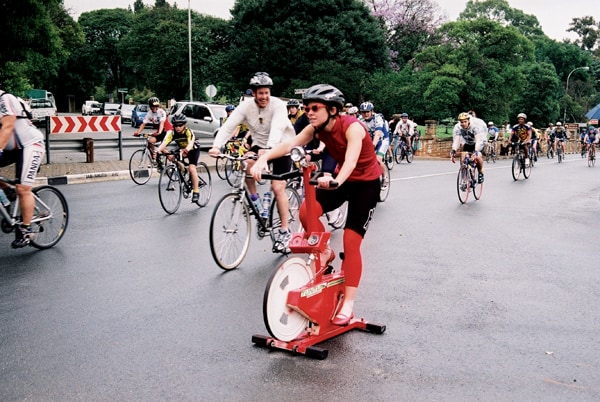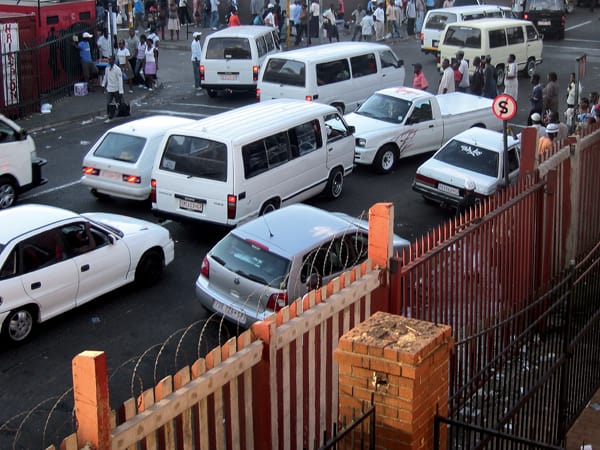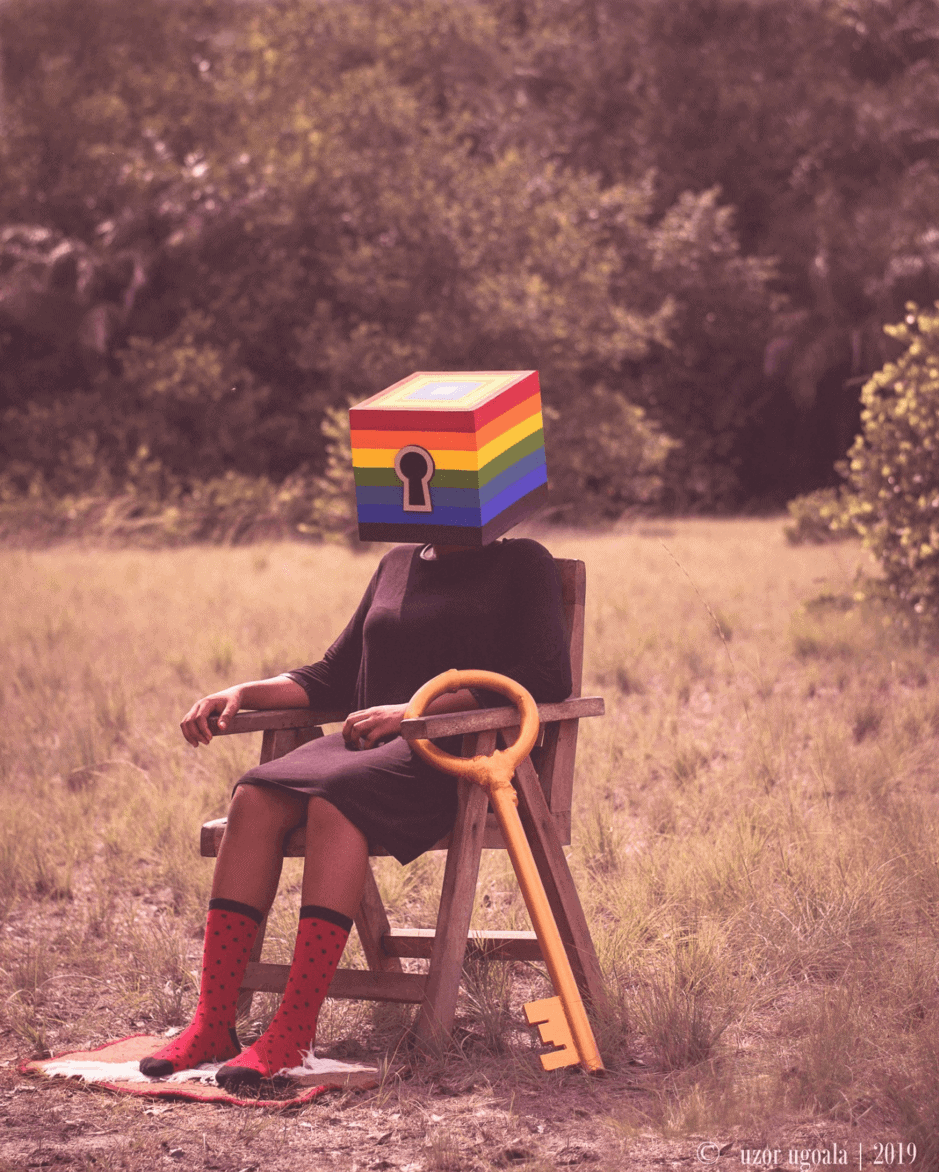First published in Art South Africa Volume 6: Issue 02
Anthea Moys; Simon Gush
PLAY WITH ME
FOR ANTHEA MOYS MAKING ART IS A MEANS TO CAPTURE, DEMONSTRATE AND REMIND ALL WILLING SOULS WHAT IT IS LIKE TO SIMPLY PLAY, WRITES TEGAN BRISTOW.

Earlier this year, on a weekday evening in August, the Bag Factory hosted RE/Action, a one-night only evening of performance art led by Johan Thom. Entering the Bag Factory, I saw Anthea Moys leading an absurdly dressed band of volunteers doing aerobics – she sported an equally absurd grin on her face. Although I’m not the participatory type, I wanted to join in and laugh at the girl who was shaking her booty the wrong way.
Moys demands very little from her audience but through her performance and video work she grabs you by the arm and reminds you of afternoons spent playing with other kids, of celebrating what your environment can offer you, of a time when you slipped in a puddle and thought it was the biggest joke on the planet. Yet it is with some weight that Moys, currently completing her MFA at Wits University, explains the seriousness of her intentions.
In early 2006 she visited Sierre, Switzerland, to participate on a Master of Arts in Public Space (MAPS) programme. It was in Switzerland where notions of play and public space come together for Moys. It started with The Accident Series, a video sequence in which she has accidents, literally. It was not her intention to make herself have accidents; Moys simply stumbled into them initially. It began on an exploratory walk one sunny day when she jumped over a fence into a beautiful snowy field and sank neck deep into the snow. She saved herself by “snow swimming” out.
“This experience signifies for me what play really means,” says Moys. “The situation was both potentially playful and dangerous, and it is in the tension between these two that my ideas of play exist.
Once Moys had swum out, she set up her tripod (which had swum out with her) and videoed herself swimming in the snow.
With its bright contrast in colour and activity, The Accident Series is reminiscent of the video work of Swiss artist Pippilotti Rist. In one segment, Slipping, Moys slips on ice over and over until she falls and knocks her head; in Sliding she literally slides down a slippery slope until she cuts her finger on the ice. These anxious yet funny works demonstrate Moys’ fascination with play: not only does she play with the limits of the environment, she also pushes at her own capabilities, pushing until something like a bleeding finger intervenes and it’s game over.
“Play is a transitory thing which relies on existing structures,” says Moys, unpacking her notion of play. “In play we subvert the real intentions and functions of structures in our immediate environment.” On her return to Johannesburg last year, Moys participated in the 94.7 Cycle Challenge: dressed in full cycle gear, she placed her exercise bike on a busy stretch of road and cycled along – only she was not going anywhere. “The act was somewhat anecdotal, now you see it, now you don’t. It was my engagement with the present moment while everyone else was engaged with the overwhelming goal of winning.”
Moys’ vital interventions, which have manifested on a number of occasions and locations around the city this year, are designed to shift peoples’ perspectives on everyday events and bring fresh potential to overly functional environments. Most recently, at the end of September, she organised the public spectacle, Have City Will Play. “We are taking advantage of the ‘safe’ area set up in Newtown Johannesburg by the Arts Alive Lockdown,” Moys declared. She arranged a Nonsensical Obstacle Course, a competitive race consisting of seven games on and around Mary Fitzgerald Square. For many it was an invitation to explore a space they had only driven through previously, for others it enabled a moment of playful engagement between strangers on the street. Most memorable for me was watching players, who were gratifyingly following rules, trying to convince passersby to participate in a three-legged race. Picture a weedy computer geek convincing the female vendor selling pap to hop down the road; or seeing a team of security guards volunteering their services by guarding and guiding blindfolded players as they navigated a minefield of market stalls. With the most serious intentions Moys had a whole street of people laughing.
Tegan Bristow is a Johannesburg based artist and lecturer in interactive digital media at Wits School of Arts.
About Anthea Moys: Since completing her BFA in 2004, Johannesburg-based Moys has participated on numerous group exhibitions, including Trasi Hennen’s curated show of video art, Art in the Dark (2005), Kazoo – it’s a live art thing at The Premises Gallery (2006), and Armed Response 2 at the Goethe Institut (2007), which she co-curated. A participant on Kin:Be:Jozi, an exchange project between artists from Bern, Kinshasa and Johannesburg, Moys recently presented Interruption, her debut solo exhibition in fulfilment of her MFA, at Intermission Gallery, 195 Jeppe Street, Johannesburg. Moys’ video piece, Snowswimming, has been selected for Spier Contemporary. To view Boxing Project, visit http://kinbejozi.blogspot.com/ or www.antheamoys.com .
UNCOMMON GROUND
WHILE ON A RECENT VISIT TO CHILE, SIMON GUSH CHATTED WITH PHILIPPE VAN CAUTEREN AND THOMAS CARON, OF BELGIUM’S SMAK MUSEUM IN GHENT, ABOUT LATITUDES, TAKING POSITIONS AND SLOWING DOWN THE CONSUMPTION OF ART.

Philippe Van Cauteren: Santiago is on the same latitude as South Africa. I mention this because, in your work, you are investigating contexts, environments or situations. How do you perceive Santiago?
Simon Gush: I find it difficult to make general statements about Santiago. I am reluctant to comment after such a short time.
PVC: However, your site-specific action in Kolkatta, India, Moving House (2006), which was also produced during a short period of time, could be read as a comment on that context. You specifically chose the Chaudhuri Bari as your location and hired seven bicycle rickshaws to try to pull the building forward.
SG: I was interested in exploring the question of working in a foreign context. I think that when an artist does this there is a transaction that takes place whereby s/he often takes more than s/he gives. The experience of riding in the rickshaws in India was interesting for me in relation to this because the drivers have their own power, in the sense that they are unionised and therefore have agency. But even if one is aware of this, one is still paying to be pulled along by another human being. I found it very uncomfortable. I wanted to somehow expose this kind of feeling. The work, Moving House, is as much about the hiring of the rickshaws as it is about them actually trying to pull the house forward.
PVC: Artists from Chile are often connected to history of Pinochet’s dictatorship or the genealogy of Chilean contemporary art. As a young artist with a particular relationship to apartheid, how does the political history of your country affect you in positioning yourself as an artist in other contexts?
SG: Since moving to Europe, I have been more aware of the extent to which growing up in South Africa has defined how I approach the world. Having said this, I don’t want to be seen as a South African artist exclusively. I think this label has too much of an effect on the manner in which a non-South African audience reads the work. I try to avoid this because the viewer tends to rely on preconceived ideas when interacting with a piece.
Thomas Caron: But can you distance yourself from being South African when the subject matter of your work is involved in having grown up in this context? For example, your interests in power relationships?
SG: I think that it is important that South Africans start to position their discussions in a more global context and to participate in broader discussions. The things I am interested in don’t only exist in South Africa.
TC: Is it possible to transport these issues to a global level when they are always very context specific?
SG: I don’t feel that when I am working in Belgium, Chile or India that my issues are South Africa specific. My aim is to try to avoid generalisations by examining how particular details in different situations might contribute to a larger debate.
PVC: In one of our earlier discussions, you were the only participant to say that an artist should take a position. How do you position yourself as an artist and how do you see the position of the artist in general?
SG: I don’t try to take a static or overriding position but I do think that there is a need for artists to take some responsibility for the system in which they have chosen to work. As an artist, one has agency and a voice along with access to a public. In relation to the market, for instance, I don’t feel I am outside of it. Artworks that are openly critical of the market are often rapidly absorbed into it, for example the work of Santiago Sierra. I think the art market is a reflection of global capitalism. The latter’s power is mirrored in the strength of the market. I feel I have a responsibility to act within it to try to slow down the consumption of the art I produce. I would like it if there was a way of withholding something in the work, so that there is a part that can’t be bought and sold.
TC: But how does your action 21 Gun Salute for the Death of A Collector (2007) resist the market? You are selling something, in this case a 21-gun salute that can only occur once the collector has died.
SG: The work is part of the market and designed accordingly. There is a literal withholding of the work in the sense that the collector can only have the work after s/he dies. But more importantly, it proposes a different relationship with the collector. The certificate that contains both of our details links us. Therefore, I have to take responsibility for my association with the collector and s/he must take on a different responsibility to the work. The collector is legally bound not to sell the work until after the completion of the performance. It therefore cannot be an investment for the collector’s personal gain during his lifetime.
PVC: In a way, I think that many artists hide behind their work. I have the impression that you are not hiding behind your work but standing next to it. It is a very different approach to the things you make as an artist.
SG: I always try and implicate myself in my practice and, on some level, the audience too. For instance, in my piece with Dorothee Kreutzfeldt, 3 Point Turn (2007), I try to make the audience take responsibility for participating in the piece, even though their role is to play spectator to Sam Matentji, a former minibus-taxi driver, doing a three-point turn and driving up a busy one way road. The action was viewed from the balcony of the Point Blank Gallery as well as the people in the street that day. It was not comfortable to watch.
I think these ideas are not unrelated to Philippe’s concept, which at first might seem naïve, of attempting to make a manifesto in the 21st century. The whole process demands complicated questions about our ability to engage with politics. It makes an attempt to take some positive action, even though one goes in with the knowledge that there may well no be any concrete results from it. It was about process.
Philippe Van Cauteren is artistic director of SMAK, the Municipal Museum of Contemporary Art in Ghent, Belgium; Thomas Caron is curator at SMAK.
About Simon Gush: Born in Pietermaritzburg (1981), Gush completed his BFA at Wits (2003). Currently a Candidate-Laureate at the Hoger Instituut van Schone Kunsten (HISK) in Ghent, Belgium, he recently held his first commercial exhibition, Salute, at Michael Stevenson Gallery. Founder and curator of the Parking Gallery, a temporary project space on Pritchard Street, Johannesburg, he has participated on numerous group exhibitions, including Out of Place, Open Archive # 1, at Argos in Brussels, and Preview, at the Point Blank Gallery, Johannesburg (2005).
This is an edited version of a discussion held in Santiago, Chile on October 30, 2007, during the preparation of the exhibition El Manifiesto de Santiago/ Das Santiago-Manifest, initiated by Philippe Van Cauteren at the Matucana 100 cultural centre. The project attempted to write a manifesto as its major focus and included Gush as a participant. For further information: www.m100.cl.



